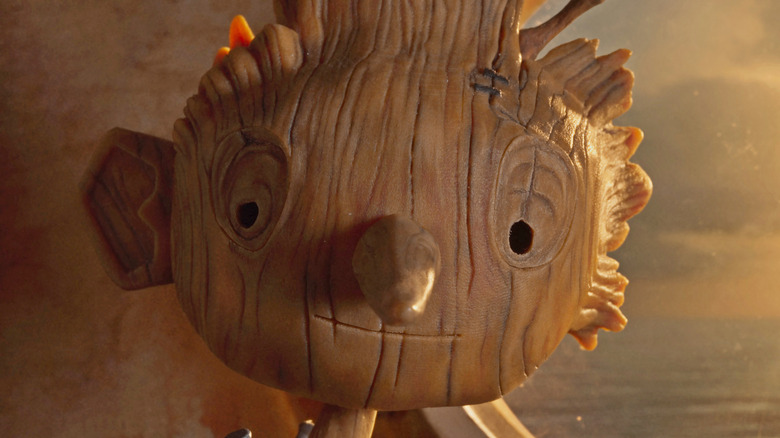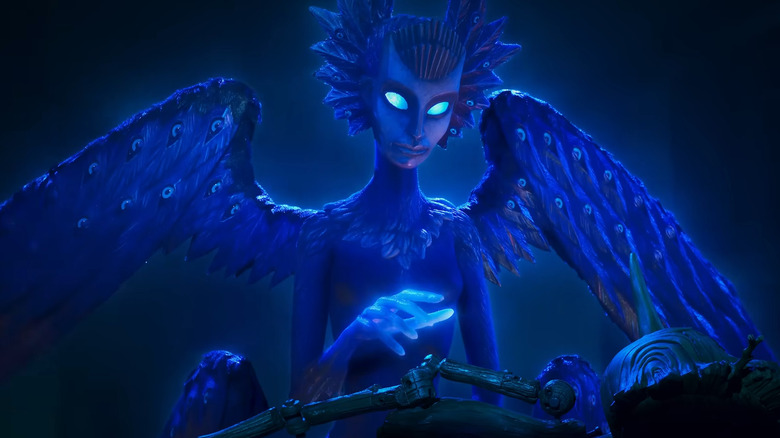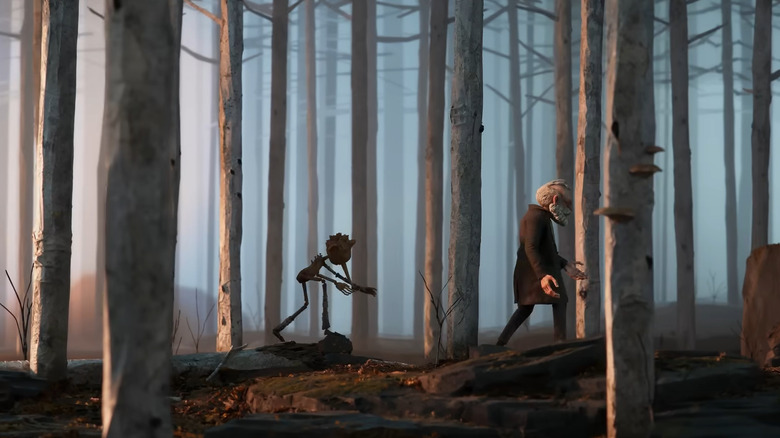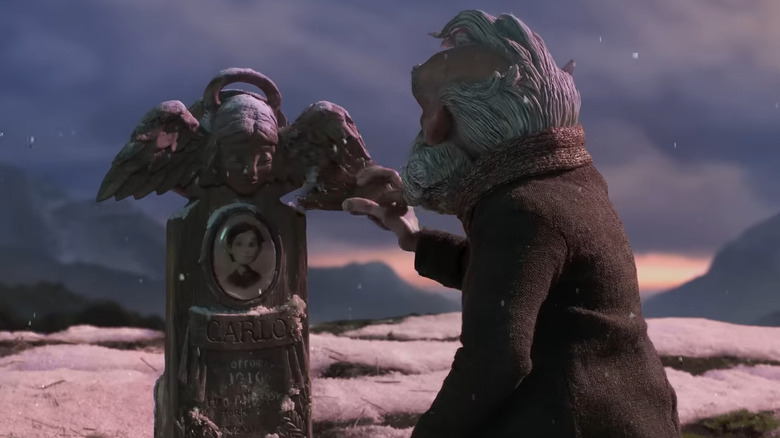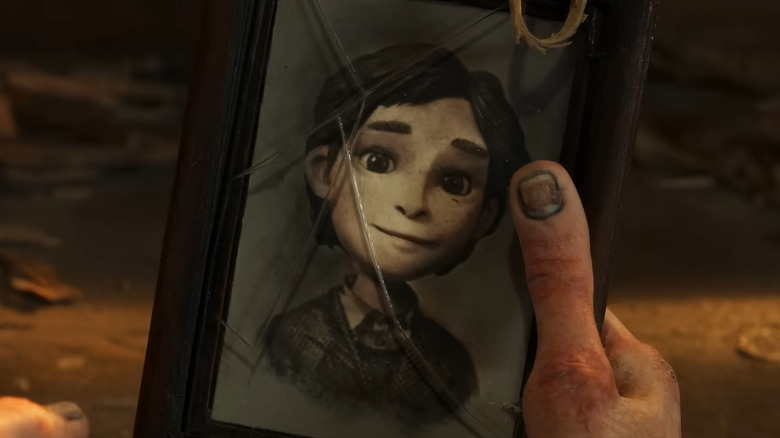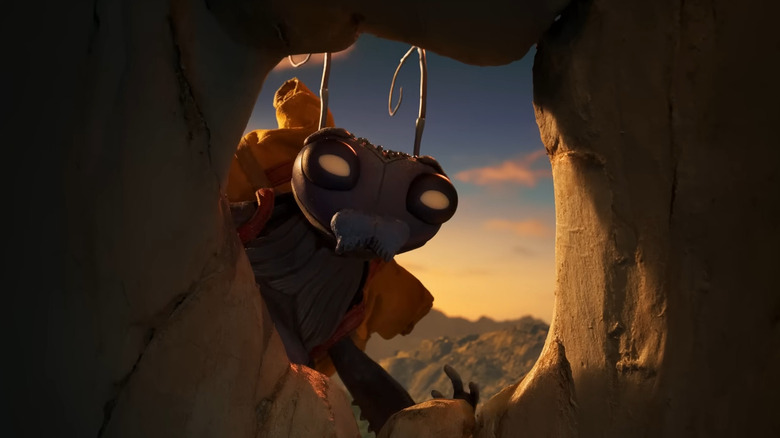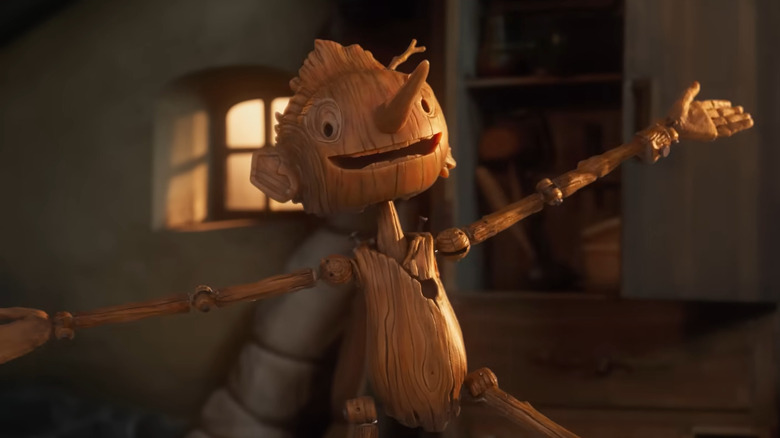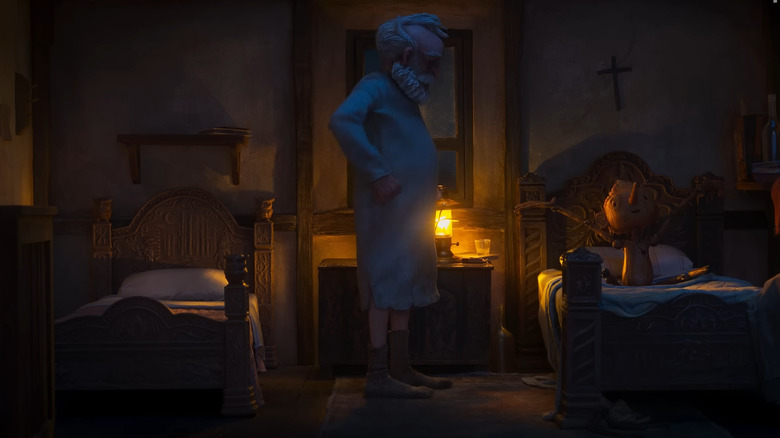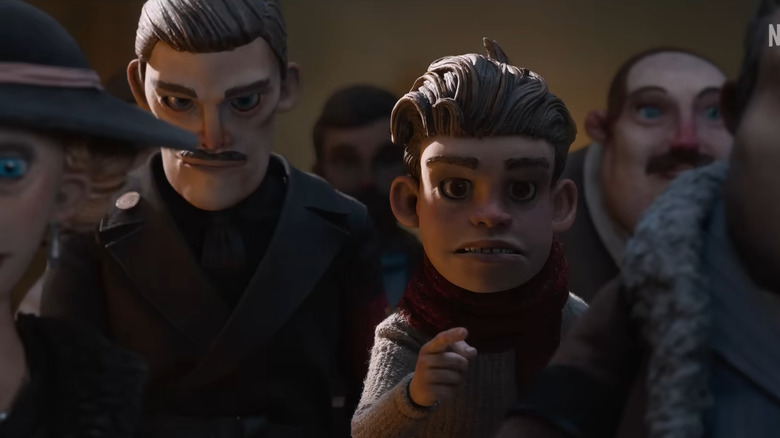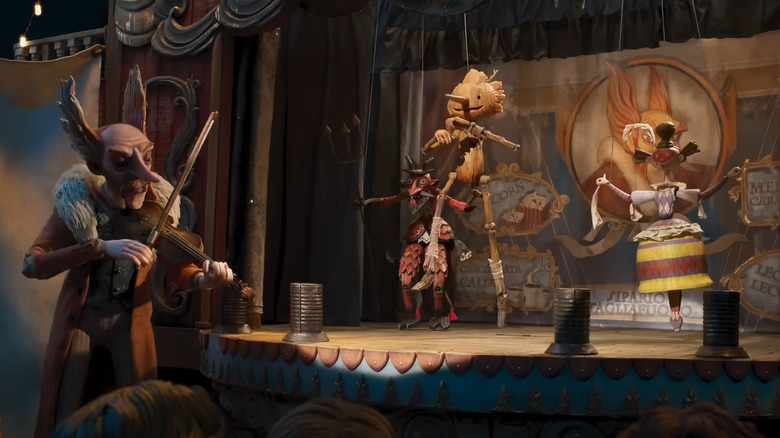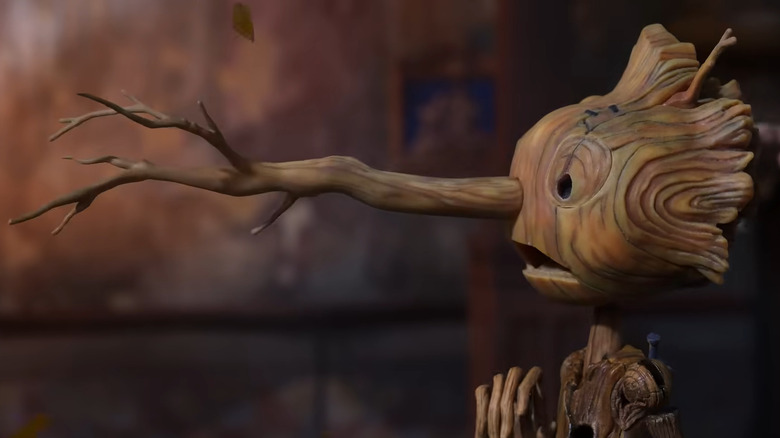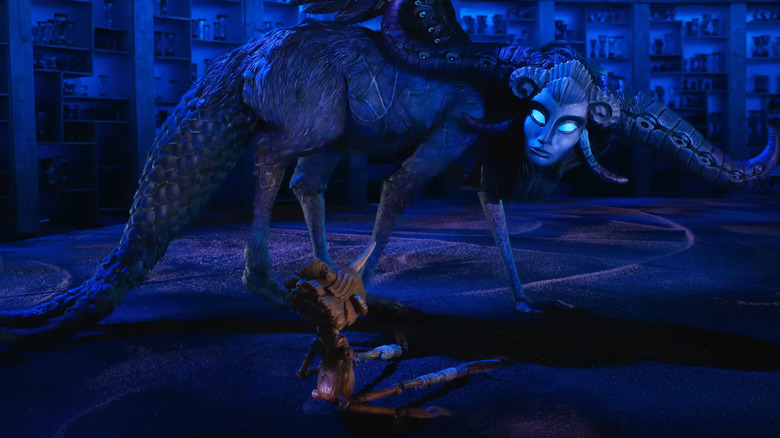Things Only Adults Notice In Guillermo Del Toro's Pinocchio
This article contains spoilers for "Guillermo del Toro's Pinocchio."
If you thought you didn't need another version of "Pinocchio" in your life, think again. Granted, no one would blame you for thinking you've had your fill. From 2000's disappointing made-for-TV musical "Geppetto," which cast Drew Carey as the elderly craftsman, to 2022's muddled Disney+ remake of "Pinocchio," which starred Tom Hanks and Cynthia Erivo, the recent track record for movie adaptations of Carlo Collodi's famous tale is spotty at best.
But then along comes 2022's "Guillermo del Toro's Pinocchio," a film which takes a cue from the playbook of "Tim Burton's The Nightmare Before Christmas" to include its creative leader's name prominently in its official title. Like "Nightmare," "Guillermo del Toro's Pinocchio" hopes that recognition of its visionary's style of filmmaking will attract a prospective audience, even and perhaps especially if they've written off giving another "Pinocchio" film a chance. Also like "Nightmare," it's been made using stop-motion animation.
Streaming on Netflix, "Guillermo del Toro's Pinocchio" is clearly intended to be watched and enjoyed by all ages, but not in the way that the phrase has perhaps come to mean for other films. "Pinocchio" adds a level of maturity and sophistication to its narrative and presentation that give it not just a tolerable sense of enjoyment for adults, but does so in a way that only older viewers can fully appreciate. Here are elements of the film that only adults might notice.
The unmistakable mark of Guillermo del Toro
While Carlo Collodi's original novel, "The Adventures of Pinocchio," is already quite dark itself — Pinocchio kills the cricket, for example — director Guillermo del Toro imprints his signature style on the tale that sets it apart from other rose-tinted, toddler-friendly versions over the years. This should come as no surprise. From his 1993 feature debut, "Cronos," to 2021's "Nightmare Alley," del Toro's work often has an affinity for the macabre.
That quality was front and center in 2022's anthology series "Guillermo del Toro's Cabinet of Curiosities," which, like "Pinocchio," leveraged the director's name as something of a brand unto itself. Older viewers who know del Toro's filmography can assess "Pinocchio" as part of the director's auteurship, as one volume in a longer list that collectively paints a picture of del Toro's artistry. The film is a heartwarming story of a father and son, but it isn't afraid to take the story to darker depths and moodier qualities than we might associate with "Pinocchio" in general.
While del Toro's name is unmissable in the film's title, he's not the only director. Joining him in helming the movie is Mark Gustafson, a stop-motion veteran who previously directed 1992's "Claymation Easter" and was an animation director on 2009's "Fantastic Mr. Fox." Gustafson's experience with the artform undoubtedly complemented del Toro's skills as they shared directing credit on "Pinocchio."
Breathtaking stop-motion animation
The animation in "Pinocchio" is nothing short of stunning. While kids might know what stop-motion is, there is a level of admiration that older viewers can probably ascribe to this film more than the younger set. To be certain, "Pinocchio" isn't just a pretty presentation of a flimsy movie. On the contrary, it's filled with rich storytelling that becomes easy to get swept up into. But the viewer who remembers to take a step back and marvel at the craftsmanship of the animation is rewarded.
Every frame is a work of art, with some effects dazzling to the point of wondering how they could have possibly been accomplished. Any style of animation is a painstaking labor of love by its artists, and stop-motion is no exception, especially given its rarity in comparison to more commonly used animation methods. There is a level of care to "Pinocchio" that perhaps would have been easy to forego in its production, but whose presence makes a huge difference, from the way the sunlight seeps into the church windows upon Geppetto to the way the creature representing Death is designed with such intricate attention to detail. (And if you enjoy "Pinocchio," you may want to follow it up by viewing a flick from our list of other adult-friendly stop-motion movies.)
The context of the airplanes that bomb the village
"Guillermo del Toro's Pinocchio" takes place in Italy, and its opening moments are set during World War I. Rather than shying away from history, the film chooses to contextualize its narrative by including events from the war as vehicles to progress the story. The entire film is set into motion when fighter planes bomb a small Italian village, killing young Carlo (voice of Gregory Mann), son of local woodcarver Geppetto (voice of David Bradley). To make the situation even worse, the planes aren't engaged in any sort of combat. They simply drop their payloads to reduce their weight.
Children who haven't learned about World War I might not fully grasp the scope of this moment, or may simply fill in the blanks of their own imagination concerning the planes. They certainly don't need to be historians to see that an airplane dropping an explosive and killing Carlo is a tragedy. Even if they don't understand the context, the effect remains the same. It's terrible, and it leads to Geppetto creating Pinocchio (also voiced by Mann).
This moment — along with some of the other historical events woven into the story when the film jumps ahead to the era just before World War II — might present parents with an educational opportunity. After the film, they can candidly talk with their kids about the subject of war, or provide the missing context for kids if they believe them to be old enough for such a conversation.
Geppetto spiraling
In the wake of Carlo's death, Geppetto spirals. That much is clear to anyone watching, and the narration makes note that he even stops eating. Sharp-eyed adults may notice an unspoken contributor to Geppetto's depression in the form of the liquor bottle in his hand as he cries at Carlo's grave. This small detail adds another layer of understanding that allows us to see the complete picture of how the father is handling his grief.
Everyone grieves differently, and sometimes a loss hits us profoundly in ways we never could have imagined, with a sadness unlike anything we've felt before. Geppetto reaches his lowest point, and the audience sees the context of the relationship Geppetto had with his son. This adds so much dimensionality to his character, which is often absent in versions of the story that begin with Geppetto creating Pinocchio for no reason in particular.
If you or anyone you know needs help with addiction issues, help is available. Visit the Substance Abuse and Mental Health Services Administration website or contact SAMHSA's National Helpline at 1-800-662-HELP (4357).
Why it's Sebastian Cricket, not Jiminy
Young viewers, or those only familiar with the Disney version of "Pinocchio," may wonder why the cricket in del Toro's film (voice of Ewan McGregor) is named "Sebastian" rather than "Jiminy." In author Carlo Collodi's original story, the cricket didn't have a name at all. In the 1940 film, Walt Disney and his animators named him Jiminy after a common expression at the time. According to Etymology Online, the exclamation "Jiminy Cricket!" was formerly a well-known substitute for the perhaps more sacrilegious "Jesus Christ!" The phrase was used as early as 1848 and was "popular" in print by 1901. While modern audiences may equate the phrase "Jiminy Cricket" as singularly relating to the animated character, 1940 audiences knew it as part of their language long before they knew it as a character's name.
Even if 2022 audiences wouldn't have batted an eye at del Toro's version of the cricket being named "Jiminy," that name came from Disney's telling of the story. Though del Toro empathized with Disney's version in an unexpected way in his youth, he couldn't swipe something that Disney specifically added for his non-Disney production. That being said, Sebastian's full name is "Sebastian J. Cricket," perhaps being a nod to Jiminy and making sense to viewers who don't know the wiser. If this is the case, the film cleverly avoids a copyright issue while also maintaining something that audiences perhaps expect.
Pinocchio's selective vocabulary
When Pinocchio first comes to life, he sings "Everything Is New To Me," during which he inquires about the many things he's seeing for the first time, having only just come alive moments earlier. He melodically asks Geppetto "What do you call it?" about such objects as a hammer and a tulip.
Despite this lack of common knowledge, elsewhere in the song Pinocchio seems to know quite a bit about the world, or at least enough to insert logical similes into his tune. He sings, "The world is rich with funny words. They ring like bells, those tiny words." Later, he continues, "They dance in my mind like a chorus line, those silly words of mine." So he doesn't know what anything in Geppetto's home is, but he's aware of bells and chorus lines without any life experience? It doesn't make much sense, but it's best not to think too hard about it and simply enjoy the song.
Furthermore, in his unending questions about anything and everything he sets his eyes upon, Pinocchio stumbles upon an object that looks like a cauldron inside Geppetto's house. Pinocchio asks what it is, and Geppetto awkwardly answers that it's his chamber pot. He stops short of elaborating what the item is used for, and the bit of dialogue will likely go right over the heads of kids who might not have ever realized indoor plumbing wasn't always a thing.
Geppetto not being able to move on
Pinocchio becoming sentient is an unexpected occurrence in Geppetto's troubled life, and he has no time to prepare his home for immediately hosting another occupant. Geppetto is a woodcarver, and could have easily made a bed for Pinocchio to sleep in had he known his house would soon need another accommodation. This is unnecessary, though, as Geppetto has a bed readily available for Pinocchio to use. It's Carlo's old bed, of course, and viewers of any age can likely figure out that much.
What might hit home more for adults than kids, though, is the deeper meaning behind Geppetto not dismantling the bed in the first place. Despite Carlo's death happening years ago and there being no indication that Geppetto would ever need a child-size bed ever again, the man keeps the bed standing just feet away from his own and underneath the watchful gaze of Carlo's hand-drawn sketches on the wall. This all speaks to a level of Geppetto's mourning. To remove the bed would be to erase the memory of Carlo that's manifested in tangible objects, which are too precious for him to part with. He struggles to move forward with his life, which is completely understandable given his circumstances. It's just as well that the bed is ready for Pinocchio and no further arrangements need to be made.
Candlewick's dad calling him a model fascist youth
Podestà (voice of Ron Perlman) is clearly not a nice dude from the moment the audience meets him. He's the father of Pinocchio's friend Candlewick (voice of Finn Wolfhard), and constantly looks down upon Pinocchio and Geppetto. Eventually, Podestà goes full villain. His involvement with Italy's authoritarian rule in the 1930s just prior to World War II becomes a major plot point in the second half of the film. Early on, though, audience members who pay close attention to Podestà's dialogue might pick up on the character's true nature before his more obvious reveal.
Of Candlewick, Podestà notes that his son is a "model fascist youth," encouraging Geppetto to raise Pinocchio similarly. That's not just a casual attribute someone says in conversation. The word "fascist" might be a bit too advanced a vocabulary term for younger kids to latch onto, and they might just take Podestà as being a typical small town movie bully. Later, though, it's clear: this guy means war.
Mussolini is straight-up a character in this movie
"Guillermo del Toro's Pinocchio" has obvious connections to real-world events that run parallel to its story, but things get amped up to a whole new level of reality when characters start referencing Benito Mussolini by name. Count Volpe (voice of Christoph Waltz) reveres Mussolini, who he frequently refers to as "Il Duce," or "the leader" in Italian, and is thrilled that Pinocchio will perform his act in front of Mussolini. Wait, what? Yes, it happens, though Pinocchio takes the opportunity to pull a prank. "Pinocchio sings about poop to Mussolini" probably wasn't on anyone's bingo card going into this movie, but here we are.
Through the lens of characters like Count Volpe and Podestà, the audience sees the disturbing impact of Mussolini's message in ways that are difficult to grasp today. As Encyclopedia Britannica notes about the time period, "Many Italians, especially among the middle class, welcomed [Mussolini's] authority." Mussolini, who would later rub shoulders with Hitler during World War II (after the events of "Pinocchio"), ruled an authoritarian Italy with prejudice and terror, to say the least. His bit part in this film might seem like just another movie villain — perhaps even an unimportant one, given his screentime — to kids who haven't learned about this era of world history. To adults aware of the bigger picture, though, it's a bit crazy to process that a terrible, real-world dictator is canon within this version of "Pinocchio."
Pinocchio's reaction to flames is inconsistent
Early in the movie, when Pinocchio is still very new to the world and discovering everything for the first time, he gets a little too close to the fireplace and his feet catch on fire. Though Geppetto is rightfully alarmed and frantically puts out the flames, Pinocchio seems thrilled. There's no indication that he's in any pain whatsoever. If anything, he strangely enjoys it.
Toward the end of the film, Volpe attempts to burn Pinocchio at the stake. This time, Pinocchio seems to feel the flames and cries out in pain. There's no major change that's happened between these two moments that would cause Pinocchio to suddenly be able to feel things differently. He's not a "real boy," and is still made of wood. While being set on fire if you're a wooden boy is obviously problematic, Pinocchio seems distressed beyond just the fact that he could be destroyed. The flames seem to actually hurt him, a discrepancy that might have merely been overlooked by the filmmakers, but is altogether unimportant to the story at large.
We never learn what Pinocchio wanted to ask Death
Thanks to the magic of the Wood Sprite (voice of Tilda Swinton), when Pinocchio gains sentience, he's also immortal. If he experiences anything that would kill him if he were human, he's briefly sent to an afterlife realm, but then almost immediately returns to his earthly form, unharmed. As it happens, Pinocchio dies quite often, and each time he dies, he visits with a creature called Death (also voiced by Tilda Swinton).
The first time he speaks with Death, Pinocchio mentions that he has an important question to ask her. However, the sand counting down his return to his body runs out and he vanishes before he gets the chance to ask his question. This is set up to feel like an important plot point, as if whatever Pinocchio was going to ask will be crucial to the story later on. But this is oddly not the case. While Pinocchio continues to ask Death about the lore and rules of the afterlife each time he sees her, he never gets around to directly addressing whatever it was he was going to ask her the first time. What feels like a set-up for a key plot point that will be clarified later never returns to the surface.
